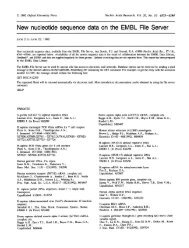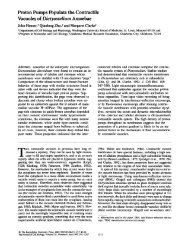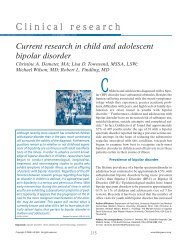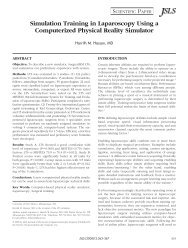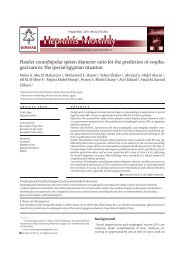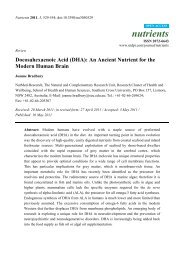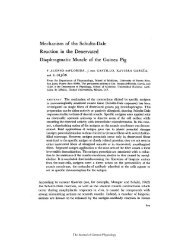Laparoscopic Suture Repair of a Perforated Gastric ... - BioMedSearch
Laparoscopic Suture Repair of a Perforated Gastric ... - BioMedSearch
Laparoscopic Suture Repair of a Perforated Gastric ... - BioMedSearch
Create successful ePaper yourself
Turn your PDF publications into a flip-book with our unique Google optimized e-Paper software.
<strong>Laparoscopic</strong> <strong>Suture</strong> <strong>Repair</strong> <strong>of</strong> a <strong>Perforated</strong> <strong>Gastric</strong> Ulcer in a Severely Cirrhotic Patient With Portal Hypertension: First Case Report,<br />
Gentileschi P et al.<br />
Figure 7. An omental patch was also sutured to the gastric wall.<br />
Figure 8. A minor leak from the gastric wound was observed<br />
with a Gastrografin study.<br />
380 JSLS (2003)7:377-382<br />
operative hepatic failure and sepsis with the potential <strong>of</strong><br />
multiple organ failure are the main reasons for such poor<br />
results. Based on these considerations, cirrhosis <strong>of</strong> the<br />
liver has traditionally been considered an absolute contraindication<br />
to laparoscopic surgery.<br />
Recently, several authors 2-4,8,9 demonstrated the feasibility<br />
and safety <strong>of</strong> the laparoscopic approach to uncomplicated<br />
abdominal operations in cirrhotic patients.<br />
<strong>Laparoscopic</strong> cholecystectomy, for example, has been<br />
extensively reported to be safe in patients with cirrhosis.<br />
2-4 Whether the laparoscopic techniques can be<br />
extended to complex digestive operations in such highrisk<br />
patients is yet to be determined.<br />
A perforated peptic ulcer is a condition for which a<br />
laparoscopic approach to repair has attractions. Not only<br />
are the location and pathology <strong>of</strong> the perforation identified,<br />
the procedure also allows closure <strong>of</strong> the perforation<br />
and extensive peritoneal lavage without a large abdominal<br />
incision. The laparoscopic repair <strong>of</strong> a perforated duodenal<br />
ulcer was first reported by Nathanson 10 in 1990.<br />
Since then, laparoscopic techniques for perforated peptic<br />
ulcers have rapidly evolved, with the development <strong>of</strong><br />
both sutured and sutureless repair. 11-13 <strong>Laparoscopic</strong><br />
suture repair is a widely accepted treatment for perforated<br />
peptic ulcers. Several trials 14,15 have described the<br />
safety <strong>of</strong> this technique. <strong>Laparoscopic</strong> sutureless repair<br />
using fibrin glue and a gelatin plug has also been shown<br />
to be safe in a randomized trial. 12 For both techniques,<br />
therefore, evidence is accumulating on their feasibility<br />
and efficacy. Furthermore, a reduction in wound pain<br />
and hospital stay has been reported compared with that<br />
in the open repair. 16<br />
Only 1 patient with cirrhosis <strong>of</strong> the liver and perforated<br />
duodenal ulcer treated by laparoscopy has been reported<br />
in the literature. 17 The closure was obtained with an<br />
omental patch, irrigation, and drainage. <strong>Suture</strong> closure<br />
was not attempted to shorten the operative time in a<br />
high-risk patient. In addition, the perforation was small,<br />
measuring 5 mm in diameter. In our case, the perforation<br />
was in the gastric wall, and was larger. Furthermore, the<br />
postoperative leakage rate and reoperation rate after<br />
laparoscopic suture repair has been shown to be significantly<br />
lower compared with that in laparoscopic sutureless<br />
repairs. 18 For these reasons, we decided to perform<br />
a suture closure <strong>of</strong> the perforation that appeared complete<br />
at the methylene blue test. Our patient experienced<br />
a minor leak on the 5th postoperative day, managed by



